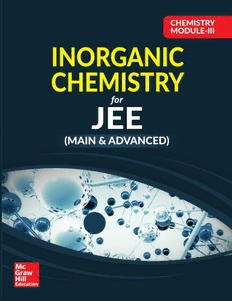
Chemistry Module III Inorganic Chemistry for IIT JEE main and advanced Vineet Agarwal McGraw Hill Education PDF
Preview Chemistry Module III Inorganic Chemistry for IIT JEE main and advanced Vineet Agarwal McGraw Hill Education
www.mheducation.co.in ISBN-13: 978-93-5260-529-3 ISBN-10: 93-5260-529-2 Inorganic chem _IIT JEE 09 March 2017 12:48:15 PM McGraw Hill Education (India) Private Limited It gives me immense pleasure to present the first edition of this book for JEE aspirants. This is an outcome of teaching experience gained through years of interaction with students preparing for JEE. The objective of this book is to provide proper guidance and relevant material to the JEE aspirants. The topics and problems of this book are framed in a way that they touch the required level of depth for each topic. All the chapters of this book have key concepts, solved examples, three levels of problems and previous years’ questions to provide a quick revision to the aspirants. The details of the salient points are given below: KEY CONCEPTS – Efforts have been made to highlight the important theories in short form. SOLVED EXAMPLES – Improve the problem-solving capacity of the aspirants in a short span of time. LEVEL-I– are the problems based on basic concepts useful for JEE Main Exam. LEVEL-II– are the conceptual problems with wide application of topics which are useful for JEE Main Exam. LEVEL-III– are the problems based on comprehension (passage), integer answer types, column matching type and one or more than one correct answer types to make the students familiar with JEE ADVANCED pattern. PREVIOUS YEARS’ QUESTIONS FOR JEE (Main & Advanced) –covers previous years’ questions asked in IIT- JEE, AIEEE and JEE Main Exam. I have tried my best to keep this book free from errors. Last but not the least, constructive criticism and valuable suggestions from the readers will be highly appreciated to make this book more precise, accurate and useful. – Author Preface v Chapter 1 Periodic Table 1.1 – 1.31 Chapter 2 Chemical Bonding 2.1 – 2.36 Chapter 3 Coordination Compounds 3.1 – 3.32 viii Chapter 4 Metallurgy 4.1 – 4.18 Chapter 5 Hydrogen and Its Compounds and S-Block elements 5.1 – 5.24 Chapter 6 d-and f-block elements 6.1 – 6.22 Chapter 7 p-Block Elements 7.1 – 7.26 Chapter 8 Salt Analysis 8.1 – 8.26 Chapter Key Concepts 20. Total number of gaseous elements : 11(H, N, O, in the periodic table F, Cl, He, Ne, Ar, Kr, Xe, Rn) 1. Lowest electronegativity : Cs 21. Total number of liquid elements in : 6 (Ga, Br, Cs, 2. Highest electronegativity : F the periodic table Hg, Fr, Unb) 3. Highest ionization potential : He 22. Smallest anion : F – 4. Lowest ionization potential : Cs 23. Liquid element of radioactive nature : Fr 5. Lowest electron affinity : Noble gases 24. Total number of radioactive : 25 elements in the periodic table 6. Highest electron affinity : Chlorine 25. Volatile d-block elements : Zn, Cd, Hg, 7. Least electropositive element : F Unb 8. Lowest melting point metal : Hg 26. Element containing no neutron : H 9. Highest melting point and : W (Tungsten) 27. Most abundant element in earth’s : Oxygen boiling point metal crust 10. Lowest melting point and 28. Rarest element on earth : At (astatine) boiling point non-metal : He 29. Most abundant metal in crust earth : Al 11. Notorious element : Hydrogen 30. Element having maximum tendency : Carbon 12. Lightest element : Hydrogen for catenation in periodic table 13. Smallest atomic size : H 31. Non-metal having highest melting : Carbon 14. Largest atomic size : Cs point, boiling point (diamond) 15. Largest anionic size : I– 32. Metals showing highest oxidation : Os (+8) 16. Smallest cation : H+ state 17. Most electropositive element : Cs 33. Most electrovalent compound : CsF 18. Element with electronegativity : Oxygen 34. Most stable carbonate : Cs CO 2 3 next to Fluorine 35. Strongest base : CsOH 19. Group containing maximum number : Zero 36. Strongest basic oxide : Cs O of gaseous elements in the group(18th) 2 37. Best electricity conductor among : Ag periodic table metals
